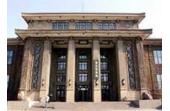Beijing Museum Of Natural History
- Things to do
-
- Photo(10)
- Tips&article(66)
- Make it Happen
- Map
-
loading...
- Other Tours
-
- Sackler Museum Of Art And Archeology
- Xiushui Street
- Beijing Railway Museum
- Beijing Folklore Museum
- Beijing Ocean Park
- Beijing
- Ancient Coin Museum
- Bell Tower
- Beihai Park
- Birds Nest
- Hutong Tour In Xicheng District
- Marco Polo Bridge
- National Grand Theater
- Beijing 789 Art Zone
- Tiananmen Square
- Beijing Military Museum
- Beijing Zoo
- The Shijingshan Amusement Park
- Wangfujing Shopping Street
- Ming Tombs
Dedicated to the collection of paleontological, botanical and anthropological specimen , this museum boasts more than one hundred thousand exhibits.While some are type specimen, some others are rare and precious treasures such as the
Upstream Yangchuanosaurus, Tsintaosaurus, Psittacosaurus specimen and some well-preserved dinosaur egg fossils and footprint fossiles. The carnivorous Yangchuanosaurus from the later Juraasic era sustained a body length of over 8 meters and body height of 4 meters; the Herbivorous Tsintaosaurus from later cretaceous ear sustained a body length of 6.
62 meters and a body height of 4.9 meters while the Herbivorous Psittacosaurus had a body of only 70 centimeters. Some imported collections include :the Moa fossils from New Zealand,sloth, Echidna, Lyrebird from Australia, La Diman fish from Africa. Some exhibits are taxidermy ,some others are fossils .
All play a very important role in the evolutionary link and have very important academic value.
Here you will find the exhibition in four sections : the Paleontology Section, the zoological section , the botanical section and the anthropological section. Diversified and advance techology like slides projector, video technology are employed to illustrate the evolution process from the single cell life to a diversifed world, from the lowest level to the highest, from water-born life to the modern world.
In the paleontology hall you can see the 22 meters-long Mamenchisaurus from 140 million years ago and the 6 meters long and 2 meter tall Lufengosaurus from 180 million years ago. Some reptiles that had the ability to fly are also on display. Pterosaur and Ichthyosaur that lived in water are on display.
They went into extinction with the dinosaurs at the same time. The zoological and botanical hall try to use the systematic evolution of life on earth to make the public aware that it took millions of years for life to be so diversified on this planet and we should try to preserve them and protect the habitat we lived in.
Anthropology hall aims at illustrating the human evolution by using paleo-anthroplogical, anthropological, anatomy and archeological materials.
Opening dates : Only closed on Mon.
Opening Hours : 9:00--17:00.
Attrations : Paleo reptiles, paleo mammals, dinosaur world and aquatic life
forms.
Tips & articles
|
|
|
forum discussion
|
|
|










